
Feeling stiff and achy after sitting all day? You're not alone: research from the Centers for Disease Control and Prevention (CDC), published November 2018 in JAMA, found one in four Americans are sitting eight-plus hours a day. And whether working, studying or browsing the internet, sitting too much can lead to tight hips and back pain.
When we stay seated for a long period of time, our knees, hips and spine are in constant flexion, which, over time, can cause both poor posture and body aches.
Video of the Day
Video of the Day
However, there are several yoga poses that are great at targeting our hips, spine, neck and back. And with consistent practice, we can help counteract the negative effects of too much sitting.
These beginner-friendly yoga poses will help your body find physical relief after sitting all day, as well as bring more awareness to your daily posture, reduce stress and help you find ease throughout your day.
No need to do them all at once — feel free to fit them in throughout your day as needed. Hold each pose for 5 to 10 breaths before repeating on the opposite side.
1. Cat-Cow Pose (Marjariasana Bitilasana)
Cat-cow opens the back and stretches the chest, shoulders, neck and spine, which makes this combo pose extremely effective and beneficial after a long day at your desk. Cat/cow also helps release any residual tension from your day.
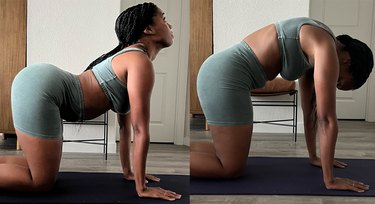
- Start on all fours with your knees under your hips and your hands under your shoulders.
- As you inhale, draw your navel in toward your spine and arch your back like a cat.
- As you exhale, starting at your tailbone, begin to extend your spine, vertebra by vertebra, until your back is arched the other way, with your belly dipping toward the ground.
- Continue slowly alternating between the two for 5 to 10 breaths.
2. Forward Fold (Uttanasana)
This essential and ache-easing pose stretches the spine, hamstrings and hips, while strengthening the spine and improving posture. And the optional arm bind helps open the chest and upper back.
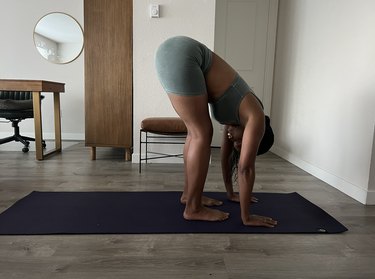
- Stand up tall in mountain pose (Tadasana) with your feet hip-width apart and your arms by your sides.
- As you exhale, fold forward, hinging at your hips.
- Place your hands on the floor beside your feet or on a yoga block.
- Keep a slight bend in your knees as you stack your hips over your knees and your knees over your ankles.
- Then, stand back up into mountain pose.
- Repeat for 5 to 10 cycles of inhales and exhales.
3. Downward-Facing Dog (Adho Mukha Svanasana)
This foundational pose stretches the entire body, but particularly targets the shoulders and spine. This pose can also help with relieving headaches that may happen after staring at your screen for a long time.
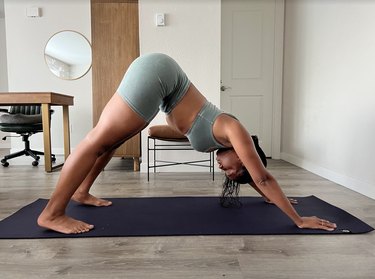
- Start on all fours, hands under shoulders and knees under hips.
- Tuck your toes under and lift your hips up, straightening your legs.
- Draw your shoulder blades down your spine and away from your ears.
- Elongate your spine and extend the back of your legs only as far as your hamstrings allow.
- Depending on your flexibility, bring your heels down toward the mat or stay on the balls of your feet with your knees bent.
- After 5 to 10 breaths, bring your knees back down to the ground in the starting position.
4. Low Lunge (Anjaneyasana)
Our hips are in prolonged flexion when sitting all day, but when we're in lunge pose, our back leg is in hip extension, which will help you find great relief.
Additionally, lunge pose is a great at stretching tight quads and hamstrings and strengthening the arms, hips, shoulders and back.
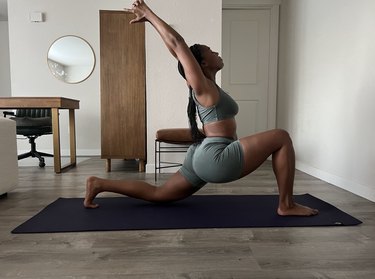
- From downward-facing dog, inhale as you raise your right leg back behind you.
- Step your right foot forward to the top of your mat. Your feet should be hip-width apart on separate tracks (they shouldn't line up front to back). Your left and right toes should both point forward.
- Lower your left knee down to your mat to create a low lunge.
- Keep your spine long by lifting your heart and extending the crown of your head away from your tailbone.
- Allow your hips to shift forward and down. You should feel a gentle stretch in your hip flexor.
- Breathe slowly and deeply for 5 to 10 breaths.
- Repeat on the other side.
5. Camel (Ustrasana)
This pose is major chest opener that helps increase mobility in the shoulders and back, while strengthening the back and upper legs. Camel pose also helps improve posture, which is key when you spend most of the day at a desk.
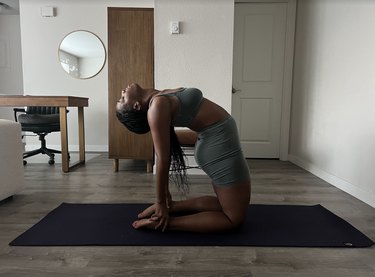
- Kneel with your knees hip-width apart, thighs perpendicular to the floor and hips open.
- Place your hands on your lower back with your elbows bent and your fingers pointed toward your glutes.
- Lean your shoulders and upper torso backward, opening your chest and pushing forward with your hips.
- As you exhale, drop back, press your pelvis forward and elongate your spine.
- Press your shoulder blades back and lean slightly to the right as you reach your right hand toward your right heel or yoga block.
- Lean slightly to the left as you reach your left hand toward your left heel. Fingers should be pointed toward your toes.
- Drop your head back and relax your throat.
- Hold for 5 to 10 breaths.
6. Garland Pose (Malasana)
Also serving as a hip opener, garland pose offers shoulder retraction (which is great at improving your posture), as you draw you shoulder blades down your back. And all of this helps combat the effects at sitting all day.
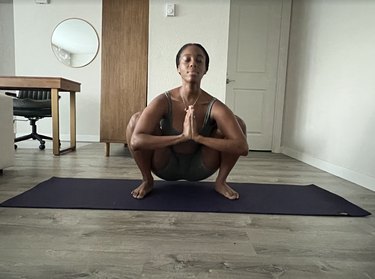
- From mountain pose, inhale and place your hands on your hips as you slowly squat to pull your tailbone down toward the floor. Keep your torso lifted.
- Walk your feet in toward your body and keep them about hip-width apart.
- On an exhale, begin to lean your torso forward and fit it snugly between your thighs as you press the weight of your body into your heels.
- Press your elbows against the insides of your knees, bringing your palms together in a prayer position (Anjali Mudra).
- Hold for 5 to 10 breaths.
7. Locust Pose (Salabhasana)
This mild backbend strengthens your arms and upper and lower back while stretching your chest, shoulders and abdominals.
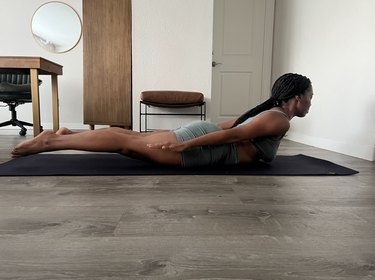
- Lie face-down on the floor with your arms resting by your sides and the palms of your hands facing down.
- Turn your legs in toward each other to ensure your knees point directly toward the floor.
- Squeeze your glutes and inhale as you lift your head, chest, arms and legs off the floor.
- Extend your arms and legs behind you, arms parallel to the floor.
- Keep your head in a neutral position as you lift up as high as possible while your pelvis and lower abdominals stabilize your body on your mat.
8. Pigeon (Eka Pada Rajakapotasana)
This graceful-looking pose opens the chest, hips and shoulders, while stretching the spine, neck, hips, thighs and abdominals. Pigeon pose also relieves tight hips that come from long hours of sitting. When practiced regularly, this pose can improve flexibility and range of motion.
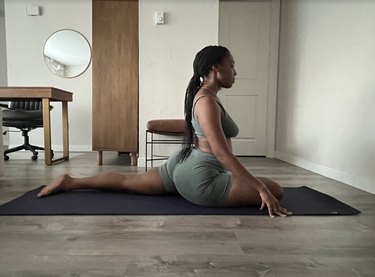
- From downward-facing dog, lift your right foot off the floor and raise your right leg toward the ceiling.
- Swing your right knee through, bend it and bring it forward, in between your hands.
- Place your right knee and shin on the floor with your knee still bent, lowering your thigh to the floor as far as your mobility allows.
- Extend your left leg behind you, hips facing forward and chest lifted.
- Press down into the floor with your hips and use your fingertips on the floor for balance, holding for 5 to 10 breaths.
- Come back into downward dog before repeating with your other leg.
9. Happy Baby (Ananda Balasana)
This yoga pose is one of the best hip openers. Happy baby decompresses your spine and stretches and loosens your hips to help reduce lower back pain.
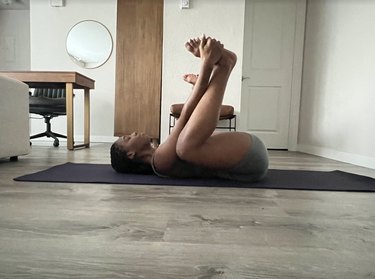
- Lie on your back, then bend your knees, allowing the soles of your feet to face the sky.
- Grip the outsides of your feet and gently pull them down toward your armpits.
- Try to keep your ankles directly above your knees so your shins are perpendicular to the floor. You should feel a gentle stretch in the inside of your hips.
- Breathe slowly and deeply for 5 to 10 breaths.
10. Supported Fish Pose
This chest opener helps counter the constant shoulder slouching that you endure when sitting all day at a computer. The support comes from yoga blocks, but a stack of books would also work.
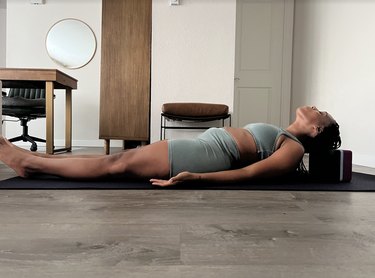
- Lie on your back with your legs together and arms close to your body.
- Place one yoga block lengthwise to rest in between your shoulder blades.
- Position the other yoga block perpendicular, underneath your head.
- Inhale as you arch your upper back and come onto the crown of your head.
- Hold and breathe for 5 to 10 cycles of inhales and exhales.
Was this article helpful?
150 Characters Max
0/150
Thank you for sharing!
Thank you for your feedback!